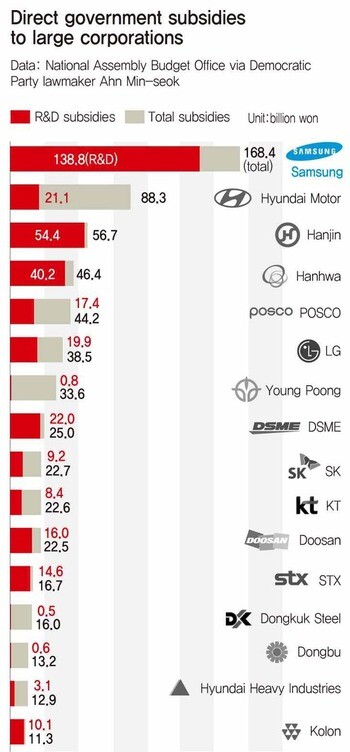hankyoreh
Links to other country sites 다른 나라 사이트 링크
Samsung receives more than US$155 million in government subsidies

By Lee Wan and Ryu Yi-geun, staff reporters
The central government gave Samsung Group over US$155 million in direct subsidies in 2012 alone, budget figures show.
The total of 168.4 billion won (US$155.3 million), which did not include indirect support such as tax breaks, put Samsung on top among South Korea’s large corporations (defined as business groups subject to cross-shareholding restrictions) for amount of government money received.
The Hankyoreh conducted an analysis on Feb. 4 using National Assembly Budget Office (NABO) figures requested through Democratic Party lawmaker Ahn Min-seok. According to the figures, a total of 730.9 billion won (US$673.9 million) in direct subsidies was given by the central government in 2012 to large corporations such as Samsung and Hyundai Motor.
The NABO tallied its direct subsidies using data on R&D budgets and private transfers “with a direct funding transfer effect” supplied by 11 government agencies, including the Ministry of Science, ICT and Future Planning and the Ministry of Trade, Industry and Energy (MTIE).
Samsung topped the list of large corporations that received the most in subsidies. The group’s defense industry affiliates received 118.4 billion won (US$109.2 million) in state R&D money, with one of them, Samsung Thales, drawing 45.3 billion won (US$41.8 million) for key technology development projects. Samsung Electronics received 180 million won (US$166,000) from the state for “research infrastructure improvements” and other items.
Next in line for subsidies was the Hyundai Motor Group, which received 88.3 billion won (US$81.4 million), followed by Hanjin (56.7 billion won/US$52.3 million), Hanwha (46.5 billion won/US$42.9 million), and POSCO (44.2 billion won/US$40.8 million). Out of the four biggest groups, LG and SK each received more than US$20 million from the government, with LG getting 38.5 billion won (US$35.5 million) and SK getting 22.7 billion won (US$20.9 million).
R&D support was the primary channel for state money to find its way into chaebol coffers. According to the NABO figures, the Defense Acquisition Program Administration (DAPA) gave 275.9 billion won (U$254.4 million) in support to big corporations, while another 268.9 billion won (US$247.9 million) came from MTIE.
The nature of DAPA research projects - which typically involve an oligopolistic supply structure between the government and corporations - suggests that the MTIE accounted for the largest amount of funds to big business.
R&D funds from the government to corporations do more than just increase their short-term profits. They are also important in supplying them with future earnings through state research projects. Companies carrying out those projects receive various types of research support from state-funded institutions in addition to their funding support.
SMEs are also forced to turn to big business to ensure successful R&D projects.
“When we’re competing for government research project orders, consortiums with large corporation involvement get higher scores because they’re seen as having a certain level of established demand,” explained the president of one SME on condition of anonymity.
The system is one where a “subsidy ecosystem” is taking root with big business as the central pillar.
Democratic Party lawmaker Jeon Jeong-hee described the situation as “problematic.”
“Huge amounts of funds are going to large corporations at a time when SMEs don’t have the means to invest in R&D,” Jeon said.
“We need to reexamine the results and effects of R&D support to big corporations so that we can form an industry ecosystem where SMEs are also able to grow,” she added.
Please direct questions or comments to [english@hani.co.kr]

Editorial・opinion
![[Column] Park Geun-hye déjà vu in Yoon Suk-yeol [Column] Park Geun-hye déjà vu in Yoon Suk-yeol](https://flexible.img.hani.co.kr/flexible/normal/500/300/imgdb/original/2024/0424/651713945113788.jpg) [Column] Park Geun-hye déjà vu in Yoon Suk-yeol
[Column] Park Geun-hye déjà vu in Yoon Suk-yeol![[Editorial] New weight of N. Korea’s nuclear threats makes dialogue all the more urgent [Editorial] New weight of N. Korea’s nuclear threats makes dialogue all the more urgent](https://flexible.img.hani.co.kr/flexible/normal/500/300/imgdb/original/2024/0424/7317139454662664.jpg) [Editorial] New weight of N. Korea’s nuclear threats makes dialogue all the more urgent
[Editorial] New weight of N. Korea’s nuclear threats makes dialogue all the more urgent- [Guest essay] The real reason Korea’s new right wants to dub Rhee a founding father
- [Column] ‘Choson’: Is it time we start referring to N. Korea in its own terms?
- [Editorial] Japan’s rewriting of history with Korea has gone too far
- [Column] The president’s questionable capacity for dialogue
- [Column] Are chaebol firms just pizza pies for families to divvy up as they please?
- [Column] Has Korea, too, crossed the Rubicon on China?
- [Correspondent’s column] In Japan’s alliance with US, echoes of its past alliances with UK
- [Editorial] Does Yoon think the Korean public is wrong?
Most viewed articles
- 1[Column] Park Geun-hye déjà vu in Yoon Suk-yeol
- 2Thursday to mark start of resignations by senior doctors amid standoff with government
- 3N. Korean hackers breached 10 defense contractors in South for months, police say
- 4Kim Jong-un expressed ‘satisfaction’ with nuclear counterstrike drill directed at South
- 5[Editorial] New weight of N. Korea’s nuclear threats makes dialogue all the more urgent
- 6Will NewJeans end up collateral damage in internal feud at K-pop juggernaut Hybe?
- 7[Column] ‘Choson’: Is it time we start referring to N. Korea in its own terms?
- 8[Editorial] Japan’s rewriting of history with Korea has gone too far
- 9[Cine feature] A new shift in the Korean film investment and distribution market
- 10[Column] The president’s questionable capacity for dialogue